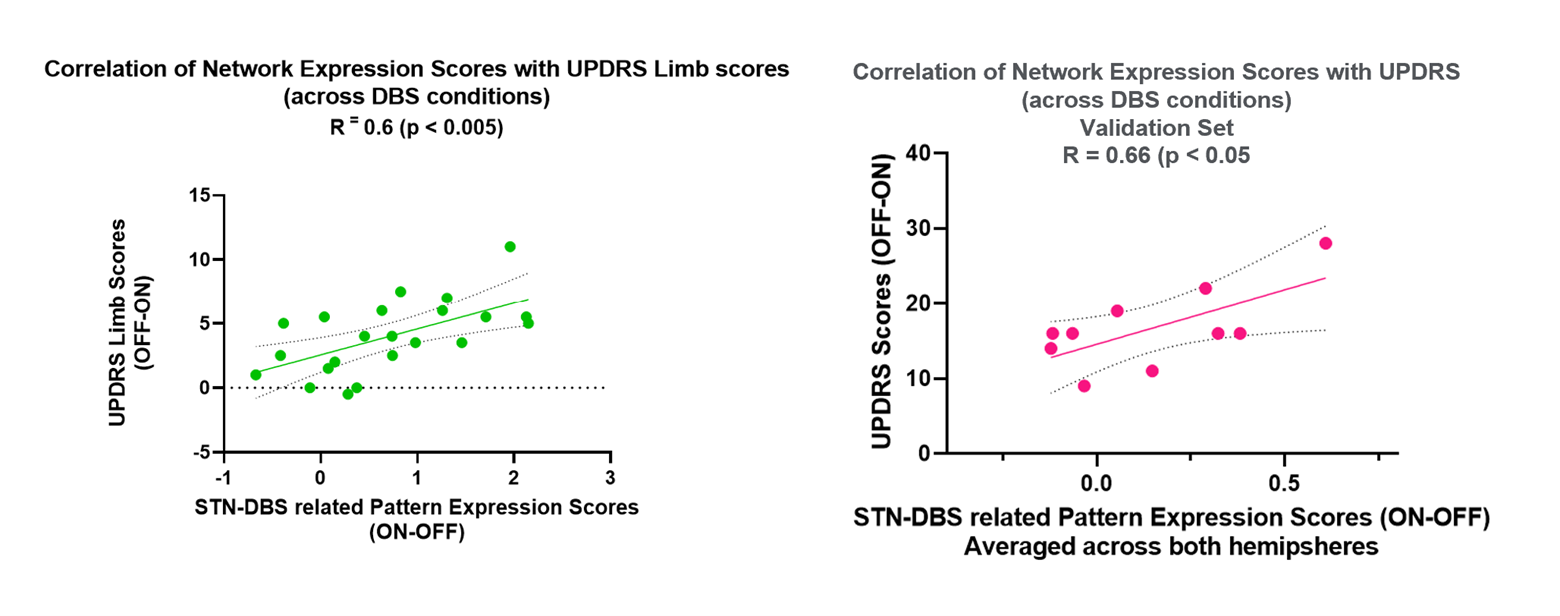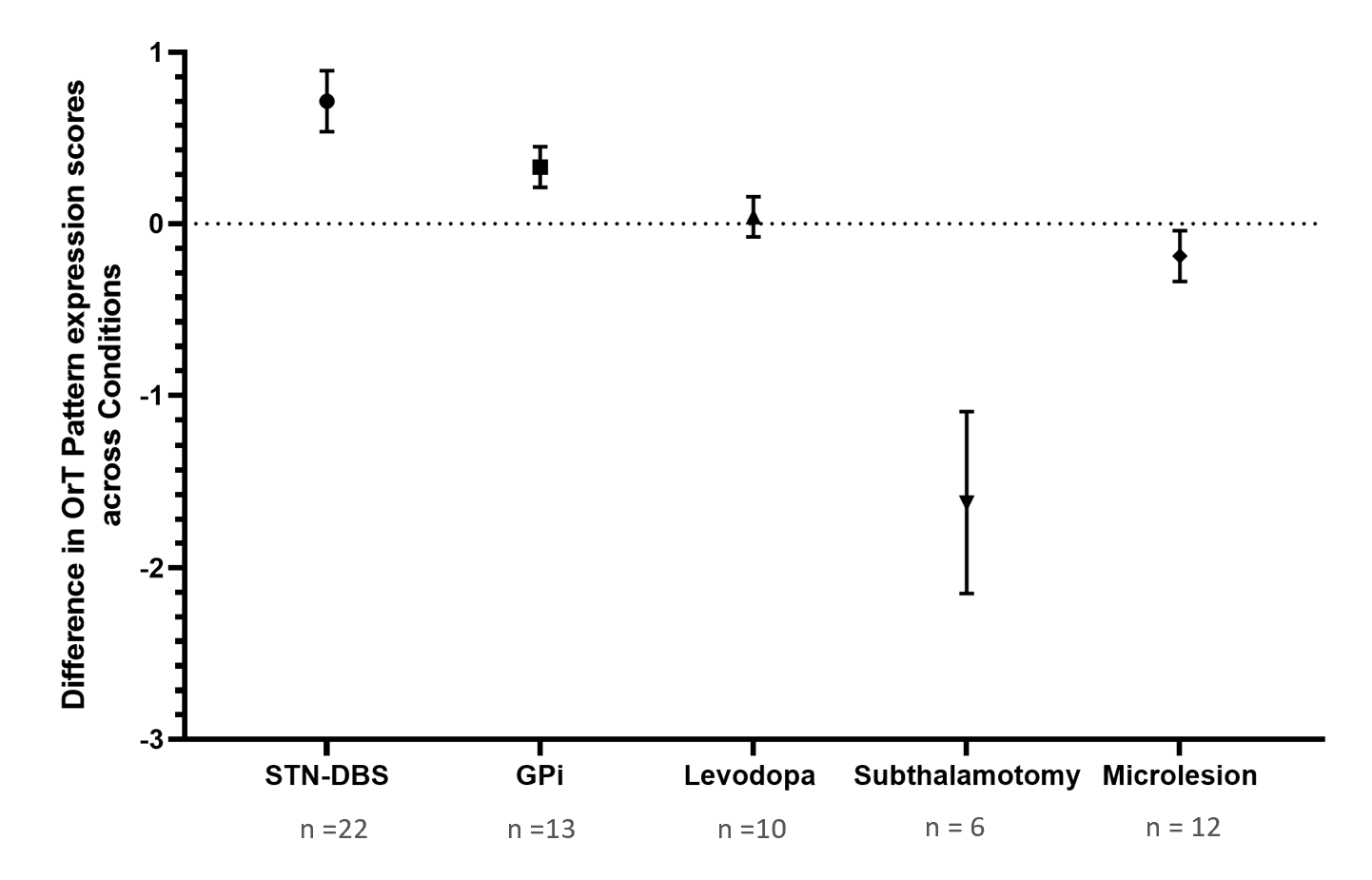Category: Parkinson's Disease: Neuroimaging
Objective: To identify a network associated with the therapeutic effects of STN DBS
Background: The network topography associated with the therapeutic effects of STN DBS are not well described. FDG PET has been used to study disease and treatment related networks in PD (1,2).
Method: We studied 13 PD patients with implanted STN-DBS electrodes (24 hemispheres) with FDG PET off medication in the on and off stimulation condition. We applied ordinal trend canonical variates analysis (OrT/CVA) to the ON/OFF scan data for each hemisphere (3). Further validation was assessed by quantifying stimulation mediated changes in an independent cohort of 13 STN DBS patients (26 hemispheres) acquired at the San Raffaele Scientific Institute, Italy (4). We assessed relationships between changes in pattern expression and UPDRS motor ratings in the derivation and validation STN DBS samples, and evaluated changes in network pattern in other therapeutic interventions.
Results: We identified a significant hemispheric spatial covariance pattern characterized by stimulation mediated increases in the subthalamic nucleus, ventral thalamus, supplementary motor area and pontine nuclei and decreases in the postcentral gyrus, cerebellar vermis and paravermian region (Fig 1). Subject scores exhibited consistent increases in the ON vs OFF conditions across hemispheres (p < 0.001, permutation test). Increases in pattern expression across subjects correlated with improvement in UPDRS motor ratings for contralateral limbs (R= 0.6, p < 0.005) (Fig 2(a)). Similar findings were seen in the validation sample, with increased pattern expression in the ON condition (p < 0.05, paired t-test) and significant correlations with motor improvement (R = 0.66, p < 0.05) (Fig 2(b)).
Significant increases in pattern expression were observed with STN stimulation but not Levodopa infusion of comparable efficacy (Fig 3). Less pronounced increases were seen with GPi DBS whereas decreases were present following unilateral subthalamotomy and microlesion (Fig 3). In the absence of treatment, pattern expression was stable in PD patients and healthy controls.
Conclusion: STN-DBS modulates a significant motor network which correlates with the therapeutic benefit. In contrast to previously characterized PD-related networks, this treatment induced pattern is modulated specifically by STN-DBS but not by other surgical interventions or dopaminergic treatment.
References: 1. Perovnik M, Rus T, Schindlbeck KA, Eidelberg D. Functional brain networks in the evaluation of patients with neurodegenerative disorders. Nature Reviews Neurology. 2022 Dec 20:1-8.
2. Niethammer M, Tang CC, Vo A, Nguyen N, Spetsieris P, Dhawan V, Ma Y, Small M, Feigin A, During MJ, Kaplitt MG. Gene therapy reduces Parkinson’s disease symptoms by reorganizing functional brain connectivity. Science translational medicine. 2018 Nov 28;10(469):eaau0713.
3. Habeck C, Krakauer JW, Ghez C, Sackeim HA, Eidelberg D, Stern Y, Moeller JR. A new approach to spatial covariance modeling of functional brain imaging data: ordinal trend analysis. Neural computation. 2005 Jul 1;17(7):1602-45.
4. Volonté MA, Garibotto V, Spagnolo F, Panzacchi A, Picozzi P, Franzin A, Giovannini E, Leocani L, Cursi M, Comi G, Perani D. Changes in brain glucose metabolism in subthalamic nucleus deep brain stimulation for advanced parkinson’s disease. Parkinsonism & Related Disorders. 2012 Jul 1;18(6):770-4.
To cite this abstract in AMA style:
P. Unadkat, S. Peng, Y. Ma, V. Dhawan, C. Tang, A. Vo, S. Caminiti, D. Perani, D. Eidelberg. Modulation of a subthalamic nucleus related network associated with motor response following Deep Brain Stimulation [abstract]. Mov Disord. 2023; 38 (suppl 1). https://www.mdsabstracts.org/abstract/modulation-of-a-subthalamic-nucleus-related-network-associated-with-motor-response-following-deep-brain-stimulation/. Accessed December 12, 2025.« Back to 2023 International Congress
MDS Abstracts - https://www.mdsabstracts.org/abstract/modulation-of-a-subthalamic-nucleus-related-network-associated-with-motor-response-following-deep-brain-stimulation/



